Examining Fallout's Sunshine Junkyard: A Deep Dive
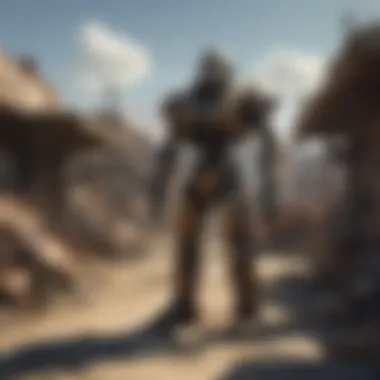
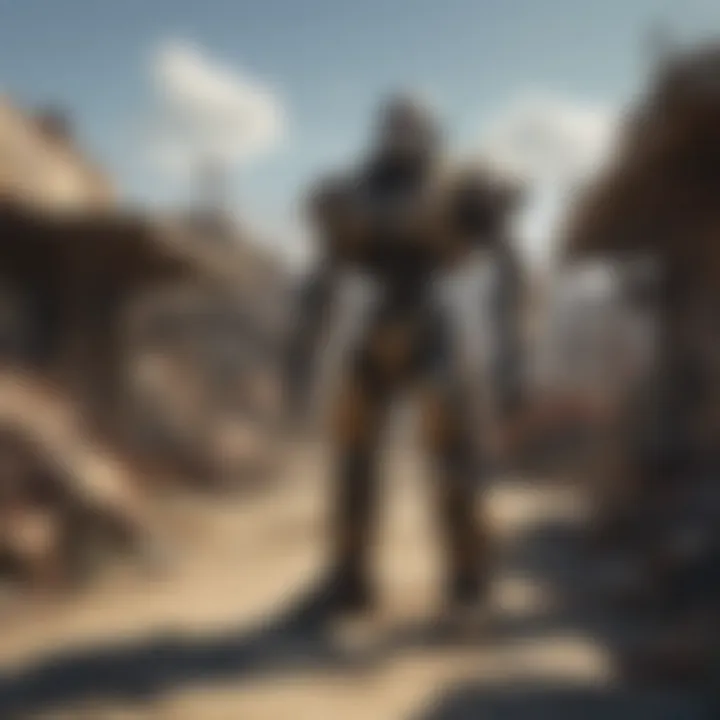
Lore Insights
In the vast universe of Fallout, the Sunshine Junkyard emerges not merely as a backdrop but as a vivid testament to the remnants of a fractured society. It serves as a striking metaphor for the decay of civilization and the struggle for survival in a world stripped to its bare essentials.
Overview of the Fallout Universe
The Fallout series presents a post-apocalyptic world steeped in an alternate history where the Cold War never truly ended. Rather than progressing into a bright and prosperous future, technological advancement led to devastating consequences. The game world is characterized by its unique blend of retrofuturism and bleak realism. Players navigate through a landscape littered with the remnants of human existence—an echo of a civilization that once flourished.
Key Historical Events in the Fallout Timeline
Delving into the timeline of the Fallout series reveals several pivotal events that shape the world:
- The Great War (2077): This event marks the zenith of destruction, where nuclear bombs obliterated major cities and transformed the landscape into a desolate wasteland.
- The Rise of the Vaults: Initially established as a means of protection and survival, the Vaults became symbols of hope and despair, housing diverse groups of humanity under varying conditions.
- The Emergence of Factions: Groups like the Brotherhood of Steel and the Institute sprang from the ashes, each pursuing their own ideologies and goals, thus further fragmenting what remains of organized society.
Deep Dive into the Backstory of Major Factions and Characters
The Sunshine Junkyard serves as a loading dock of sorts, where players encounter remnants of major factions that have shaped the narrative fabric of the Fallout universe. The Brotherhood of Steel, for instance, aims to recover technology to safeguard humanity from its own destructive tendencies, while the Raiders exhibit the contrasting reality of survivalism, often through pillaging and brutality. Then there are characters like Vault-Tec scientists whose morally ambiguous experiments reflect on the ethics of survival in the face of catastrophe.
Each faction and character contributes layers to the story, with the junkyard itself becoming a physical manifestation of the consequences of their actions.
Gameplay Tips and Strategies
For newcomers, navigating through the expanse of the Sunshine Junkyard might feel overwhelming. Here are a few strategies that can enhance the experience:
- Understanding the Environment: Pay attention to the layout. The junkyard is a maze, often filled with traps and loot that can help in crafting better weapons.
- Resource Management: Collecting scraps can be vital. Use scrap to create makeshift gear and aids, helping to survive harsher conditions.
- Engaging in Combat: It’s advisable to prioritize stealth. Many enemies roam the junkyard; a silent approach often reveals treasures that a loud encounter may not.
Character Analysis
Diving deeper into character interactions within the game provides richer context to the themes of the Sunshine Junkyard. Players will encounter a range of characters, each offering insights that expand on the overarching narrative.
- Iconic Characters: Characters like Piper and Nick Valentine bring attitudinal diversity and backstory, reflecting the broader themes of memory and loss that permeate throughout the series.
- Relationships Dynamics: Observing how characters interact—be it hostile or cordial—adds depth to the gaming experience, intertwining personal narratives with the broader storyline. Players may find themselves sympathizing with the plight of a nostalgically recalled world.
- Evolution Across Games: Notably, characters often experience growth or degradation, reflecting the larger environmental decay around them.
"The wasteland is unforgiving, a constant reminder that every decision shapes the world anew. To thrive here is to balance hope and cynicism—a difficult dance."
Community Engagement
Engaging with the Fallout community can enhance the experience manifold. Whether through forums or social media, players can exchange strategies and theories. From Reddit threads dissecting plot intricacies to Facebook groups celebrating favorite characters, the fanbase remains vibrant and active.
Foreword to the Sunshine Junkyard
The Sunshine Junkyard exists as a pivotal setting within the Fallout series, where discarded debris tells stories long lost, and every rusted car can spark a memory—both in the game and in the minds of players. This introduction aims to shed light on the various dimensions of the junkyard, emphasizing its role as a reflective surface for the broader themes of survival and human resilience in the post-apocalyptic world. By looking closer at this refuse-filled reality, one can unravel layers of narrative and mechanical significance woven into the gameplay experience.
Defining Sunshine Junkyard in Fallout Lore
In the Fallout universe, the Sunshine Junkyard can be seen as more than just an accumulation of waste. It reflects a society that has crumbled under the weight of its own hubris, yet remains a habitat teeming with life and opportunities. Firstly, the junkyard is not merely a backdrop for quests; it represents the very vestiges of civilization that have been cast aside after nuclear devastation. Within this landscape, players encounter remnants of the past—be it remnants of broken cars, dilapidated buildings, or old-world technology that speaks to the lost glories.
Moreover, this place is often regarded as a treasure trove for scavengers and survivors alike. Here, players can sift through the chaos for valuable resources and crafting materials. Items like pre-war money, old-world low-tech gadgets, and even some unique weapons can often be dug up, highlighting the ingenuity necessary for survival. This junkyard presents players with the chance to engage in resource management, pushing them to consider what is truly important as they navigate through its refuse-filled environments. Hence, this setting carries weight in the lore, directly underpinning the survivalist ideals prevalent across the Fallout series.
Place within the Fallout Universe
The Sunshine Junkyard finds its place within the Fallout universe at the intersection of history and post-apocalyptic reality. Set against the backdrop of a once-thriving civilization, it offers a gritty reminder of the fragility of society. Players wandering through this area can feel the echoes of humanity’s past dreams and failures. It's not just about scavenging; it's also about reflecting on history and understanding how different events led to such a desolate yet vibrant landscape.
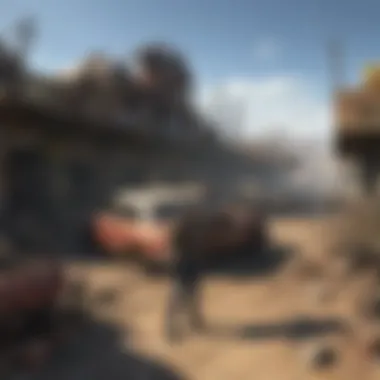
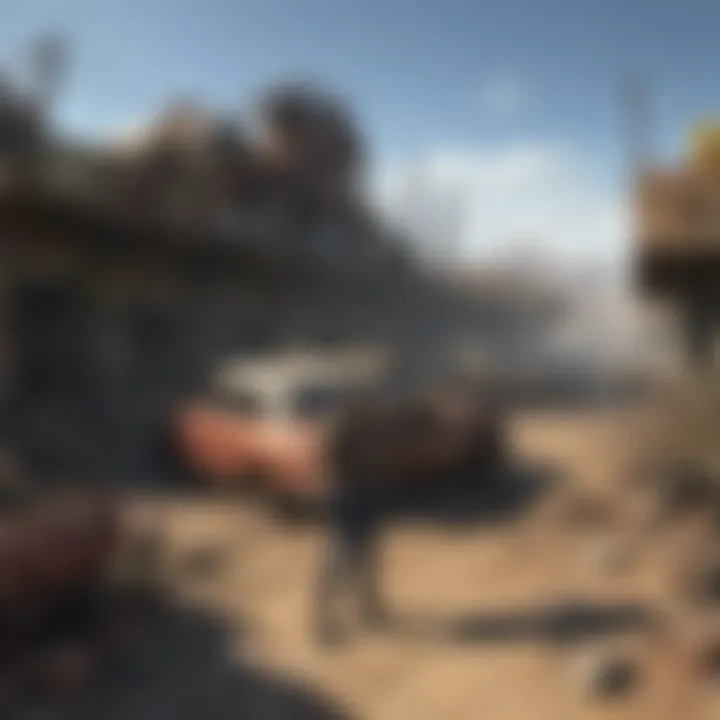
In the greater context, the junkyard serves a narrative function, helping players to grapple with themes of decay and renewal. As they explore, they might come across familiar objects from the world before the bombs fell—like classic soda cans or damaged robot parts—that allow them to connect the dots between their current struggles and the histories of those who once lived there. This connection is layered yet tangible; it deepens the emotional response that players develop towards the game’s world.
"The remnants of our past can often teach us the most about our future. In the Sunshine Junkyard, every scrap of metal has a story, waiting to be told."
Navigating through the Sunshine Junkyard isn’t merely an exploration of space; it’s an exploration of meaning—both intended and found. In summary, this location embodies the heart of what makes Fallout an enduring franchise. Players are not just interacting with the environment; they are engaging with a complex narrative fabric that evokes powerful reflections on humanity.
Narrative Significance of the Junkyard
The Sunshine Junkyard occupies a pivotal role in the narrative landscape of the Fallout series, embodying the dichotomy between the remnants of the past and the struggle for survival in a decaying world. It’s not merely a backdrop for adventure; its refuse-strewn expanse serves as a canvas where the game’s deeper themes are vividly painted. Within this space, players encounter fragments of stories interwoven with the lore, offering insights into the fractured society that once thrived before the apocalypse.
Story Arcs Connected to the Junkyard
The junkyard acts as a crossroads for several key story arcs. For many players, venturing through its twisted wreckage reveals quests that illuminate the overarching struggle for humanity in a world gone mad. For instance, the quest of scavenging materials becomes much more than a mere task; it introduces backstories of characters long forgotten, showcasing their aspirations and the realities that ultimately led to their downfall.
- Examples of story arcs include:
- Encounters with folks trying to maintain a semblance of a community amidst chaos.
- Exploration of lost technology and the echoes of civilization’s hubris.
These narratives draw players into a web of loss, hope, and resilience, pushing them to contemplate their own story while navigating through the debris of others.
Character Interactions and Development
Within the confines of Sunshine Junkyard, character interactions not only drive the narrative forward but also enrich the player’s experience. The characters you meet—be it a grizzled scavenger or a hopeful merchant—each have tales steeped in the history of the land. These encounters present opportunities for dialogue laden with choice, impacting the trajectory of the player’s journey.
As players engage with the junkyard populace, they witness firsthand the shades of character development, as relationships shift based on the moral decisions made throughout their quests. Whether it's developing kinship with characters or facing moral dilemmas, these interactions evoke a strong sense of connection to the narrative’s fluidity. For example, assisting a poor soul may offer rewards, but it comes at the cost of resources, forcing players to weigh their options thoughtfully.
"In the detritus of society, one can find the scattered pieces of humanity itself. Every character, every story adds another layer to the forgotten histories lingering in the air, compelling players to consider what they would do to survive."
Symbolism and Themes Embodied
The Sunshine Junkyard also pulsates with symbolism and themes that resonate on multiple levels. The decay visible in the junkyard symbolizes the gradual collapse of societal values and structures. Each piece of rusted metal and shattered glass reflects a past that has been lost to time, speaking volumes about the consequences of human folly and resource depletion.
A few prevalent themes include:
- Survival versus Morality
- Nostalgia for a Lost Past
- The Cycle of Destruction and Renewal
Through scavenging in this refuse-filled environment, players confront what it means to not only survive but to retain one’s humanity amid the ruins. The juxtaposition of hope and despair prevails, rendering the Sunshine Junkyard a fertile ground for deep reflection and emotional engagement. In essence, it serves as a microcosm of the broader struggles faced by characters within Fallout, reinforcing the idea that amidst the decay, the drive to forge connections and restore meaning endures.
Gameplay Mechanics Related to the Junkyard
In the sprawling universe of Fallout, the Sunshine Junkyard serves as more than just a backdrop; it is a playground for unique gameplay mechanics that shape the player's experience. Understanding these elements is crucial for anyone wishing to fully appreciate the nuanced layers of this post-apocalyptic setting. The junkyard represents a systematic approach to survival where each decision can lead to triumph or turmoil.
Resource Management and Scavenging
In the Sunshine Junkyard, resource management and scavenging are paramount. Players often find themselves sifting through heaps of debris, battling for the last bit of scrap metal or a piece of pre-war technology. This scavenging mechanic isn't merely a side activity; it’s woven into the core of gameplay. Resources are scarce, which pushes players to think creatively about what to take and what to leave behind. Not only does this encourage exploration, but it also nurtures a sense of urgency and survival instinct.
Utilizing the environment is essential. For instance, abandoned cars can yield valuable items, while also hiding threats. This interplay between resource acquisition and potential danger underscores tension in the junkyard and rallies players to engage in strategic planning. The game also rewards careful consideration of what is collected. Items like scrap metal can be used for crafting or modifications, all vital for surviving the harsh realities of the wasteland.
Combat Scenarios Unique to the Junkyard
Combat within the Sunshine Junkyard is shaped distinctly by its environment. Players must navigate tight spaces, utilize cover effectively, and consider the unpredictable nature of the terrain. The junkyard isn’t flat and straightforward; it’s a landscape filled with obstacles and opportunities for ambush. Encountering raiders is common here, and they often use the geographical features to their advantage.
Fights tend to be adrenaline-fueled as one must make split-second decisions. For example, if a player is outnumbered, they may opt for stealth to evade their foes, rather than a full-on frontal assault. This flexibility encourages varied combat strategies and tactics that adapt to the player's playstyle. The layout lends itself to creativity, as one may use discarded items as improvised weapons or traps against adversaries.
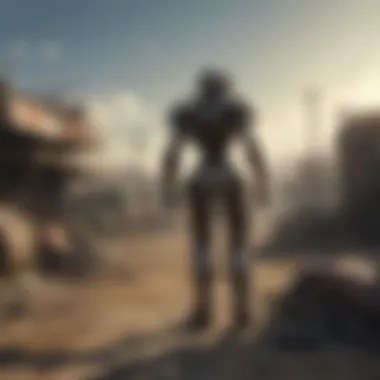

Crafting and Modification Opportunities
Crafting is a cornerstone of the gameplay mechanics in the Sunshine Junkyard. The multitude of components scattered around allows players to modify their weapons and armor, tailoring them to suit individual needs. From upgrading a rifle to improve its accuracy to crafting makeshift armor for better protection, possibilities are abundant.
The ability to analyze and repurpose found items fosters a sense of innovation. You might stumble across items like rusty gears or broken electronics, and with the right skillset, transform them into formidable gear. This not only enhances the player's armory but also facilitates a deeper connection to the environment. Crafting thus acts as a conduit for storytelling within the game. Each creation or modification carries echoes of the past and speaks volumes about adapting to an ever-changing world.
The Sunshine Junkyard pushes players to balance their instincts for survival against the risks and rewards of scavenging, combat, and crafting.
In summary, the gameplay mechanics of the Sunshine Junkyard encapsulate much of what Fallout stands for. Resource management, combat scenarios, and crafting opportunities create an engaging experience that not only challenges players but also enriches their journey through a world in tatters.
Environmental Design of Sunshine Junkyard
The Sunshine Junkyard stands not just as a backdrop in the Fallout universe but emerges as a character in its own right, steeping the gameplay experience in rich atmospherics. Its environmental design plays a pivotal role in shaping not only the player's interaction with the game but also their emotional response to its overarching themes. A cluttered yet eerily beautiful sight of heaps of debris, rusted vehicles, and remnants of a civilization long gone, the junkyard is a perfect encapsulation of decay and nostalgia. Deciphering the aesthetics and sound that fill the air helps illuminate the underlying messages that the developers wanted to convey.
Visual Aesthetics and Artistic Choices
When we talk about the visual aspect of the Sunshine Junkyard, one must consider the bold decisions made by the artists in creating this disarray. The jumbled mass of scrap metal and broken-down vehicles presents an almost surreal landscape. Bright colors juxtaposed with dirt and grime evoke a unique charm reminiscent of childhood adventures in places left abandoned. The design pulls players into a world that invites exploration while simultaneously amplifying the unsettling sense of danger that permeates the space.
The compositions play tricks on the eye, making it easy to get lost or find unexpected treasures among the wreckage. Elements like a dilapidated circus tent swirling in faded colors contribute to an unsettling aura, transports players to a time before the world fell apart, inviting contemplation on what was. The various points of interest — scattered toys, broken instruments, and lingering holograms — inspire players to piece together the remnants of past stories, providing a surface-level layered experience.
The decision to exclude overly polished graphics shrouds the environment in raw authenticity. It feels lived in, albeit left behind. The designers took cues from wasteland aesthetics while simultaneously threading modern artistic sensibilities. The result stands as a testament to careful attention to detail that speaks volumes about the world’s lost glory and its societal implications.
Sound Design and Atmosphere
As vital as visuals might be, the auditory experience in the Sunshine Junkyard firmly roots players within this chaotic realm. The sound design accomplishes more than merely enhancing authenticity; it provides an almost visceral immersion. The creaking metal, rustling debris, and echoes of your footsteps remind you that you tread on haunted ground.
In the stillness punctuated by sudden rustles, players often find themselves holding their breath. Whispers of the past seep through ambient soundscapes, carrying the weight of forgotten lives and lost dreams. A particularly striking feature is the use of contrasting sound: the lively chirping of birds hinting at resilience amid decay, unnervingly clashing with the echoes of silence left by humanity's absence.
"The Sunshine Junkyard thrives not just on sights but sounds, creating an ambiance that resonates with players long after they leave the digital wasteland."
Each note of the haunting background music swells and dips in rhythm with the chaotic visual elements. These snippets of auditory storytelling evoke emotions reminiscent of loss and longing, supporting the thematic core of survival amid desolation. Artfully crafted interactions with the environment — from scavenging metals to confronting mutant foes — bond the audio cues to player actions, urging players to recognize that sound and visuals are part of a broader narrative.
In summary, exploring the environmental design of the Sunshine Junkyard paints a compelling picture of a world icy in its stillness yet vibrant in its storytelling potential. The confluence of visual aesthetics and sound design brings this space to life, allowing critical examination of its role within the greater Fallout universe.
Cultural Reflections in Sunshine Junkyard
The Sunshine Junkyard is more than just an environment in Fallout; it serves as a powerful reflection of society's values and struggles. This section explores how the junkyard mirrors the realities of a post-apocalyptic world and highlights the deeper societal messages woven into its fabric.
Representations of Post-Apocalyptic Society
In the context of Fallout, the junkyard stands tall as a landmark representing the remnants of human civilization, echoing both nostalgia and despair. The items scattered throughout tell stories of a time before the bombs fell, laying bare the fragility of society. From broken toys to rusted vehicles, these artifacts prompt players to ponder what once was. Each piece has history, intertwining individual memories with collective trauma. It's a bittersweet reminder of the past—a world full of life and hope now reduced to scraps.
The way players navigate this space becomes a reflection of their choices and values. The scavenging mechanic encourages individuals to take stock of what remains and find value in seemingly abandoned objects. Players might feel like they are piecing together a jigsaw puzzle of survival, where every item can be repurposed or traded, highlighting the resourcefulness forced upon individuals within a decaying society.
Moreover, the visual aesthetics of the Sunshine Junkyard—where nature contrasts sharply against man-made debris—depicts a struggle for dominance. It raises questions about humanity’s relationship with the environment: how industrialization and consumption have taken a toll that now leaves a desolate aftermath. This gives an insight into ecological discourse, urging players to reflect on contemporary issues such as waste and environmental degradation.
Societal Commentary Embedded in Gameplay
The gameplay mechanics in the Sunshine Junkyard embed a critique of societal norms post-catastrophe. As players traverse this compelling landscape, they encounter not just scavenging opportunities but moral dilemmas and choices that shape their journey. The interactions with other characters reflect the survivalist mentality that takes root when society crumbles.
In many ways, the characters encountered showcase varied responses to the apocalypse—some leaning toward aggression, while others cling to remnants of humanity and compassion. This diversity prompts players to question their values and decisions, pushing them to engage in a deeper moral reflection:
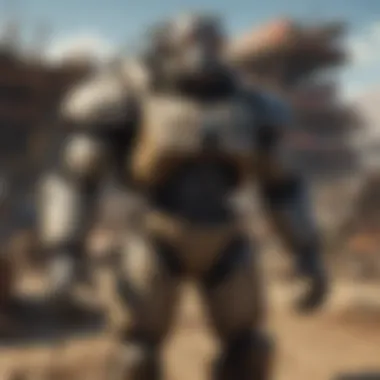
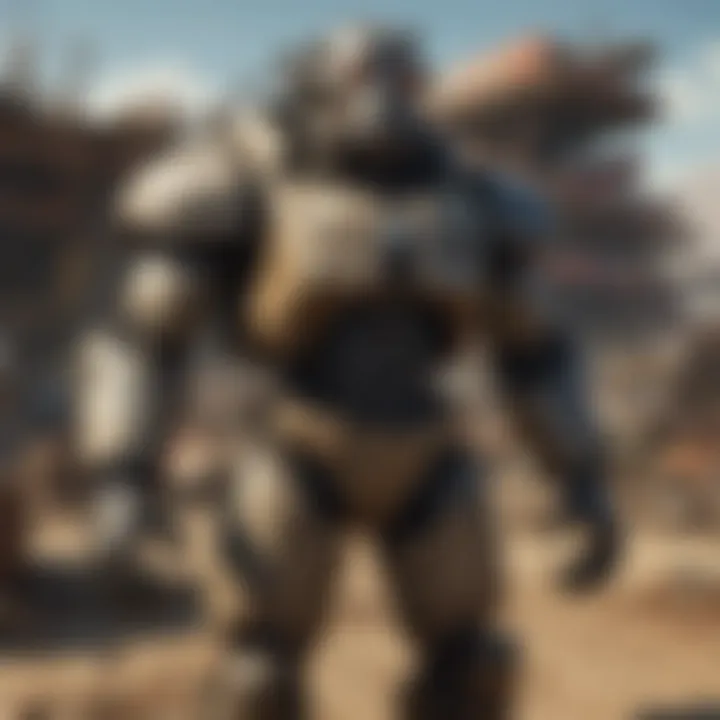
- What does it mean to survive?
- Is it necessary to sacrifice others for one’s own endurance?
The thematic undercurrents in these interactions are subtle but potent. Choices made in the junkyard offer commentary on the nature of trust, hostility, and community in stark times. Players may witness tactics for obtaining resources that include both cooperation and betrayal, reflecting the spectrum of human behavior under duress.
Moreover, as players explore the missed connections within this junk-filled landscape, they realize it's a canvas of societal reflection mirroring today’s challenges—division, resource scarcity, and loss of identity. It compels one to think how much of our current society mirrors this breakdown.
"The Sunshine Junkyard may just be a space filled with refuse, but in its depths lie the echoes of our values and the consequences of our actions."
The cultural reflections found within the Sunshine Junkyard enhance the player’s experience, creating a rich tapestry that resonates deeply with both personal and societal level explorations. In this junkyard, fragmented reflections of ourselves wait to be discovered amid the ruins.
Fan Interpretations and Theories
In the realm of the Fallout universe, the Sunshine Junkyard has become more than just a location; it stands as a tapestry woven with the threads of player experience and creativity. Fan interpretations and theories surrounding this area showcase how engaged players dive deep into the lore, providing fresh perspectives that often transcend the developers' intentions. Such discussions not only enhance the community's connection to the game but also enrich the very fabric of Fallout's storytelling.
The importance of engaging with fan interpretations lies in the multiple dimensions of understanding they provide. Each player brings their own set of experiences, thoughts, and cultural references to the table when navigating the garbage-strewn landscapes of the Sunshine Junkyard. These varying perspectives offer new insights and often shed light on aspects of the game that could easily be overlooked by a casual player. Analyzing these interpretations allows us to appreciate the depth layered into the world by the creators.
Moreover, theories generated within the community foster a sense of belonging and collaboration. Fans often find solace in discussions on platforms like Reddit or specialized forums, where they explore their speculations about the narratives interwoven within the junkyard. These conversations can lead to robust debates about recurring themes or character arcs, further drawing attention to the complexities of the game’s writing.
- Theories about the Junkyard’s origins: Many fans suggest that the Junkyard is a reflection of mankind's excesses, emphasizing how consumer culture can lead to downfall.
- Analysis of hidden symbolism: Players often dissect in-game objects, theorizing what they might represent regarding post-apocalyptic life.
This engagement promotes a thriving culture around Fallout, and bolsters the belief that every piece of scrap within the Sunshine Junkyard is significant.
Players interprett the junkyard as an emblematic warning against neglecting our resources and societies.
Community Discussions and Insights
Community discussions surrounding the Sunshine Junkyard evolve organically, driven by the diverse viewpoints of its members. Social media platforms, particularly Reddit and dedicated Facebook groups, become hotbeds for these discussions. Players share personal anecdotes about their encounters within the junkyard, from finding rare items to facing unexpected adversaries. These shared experiences often spur engaging dialogue, where fans delve into their interpretations of in-game events and choices made by the characters.
Insights derived from these conversations often reveal a deeper understanding of the symbolic weight carried by specific elements in the junkyard. For instance, the presence of consumer relics mixed with hazardous waste could be seen as a commentary on humanity's persistent wastefulness. Players routinely discuss what they think the remnants say about pre-war society, establishing a parallel with contemporary environmental issues.
Impact of Roaming the Junkyard on Players
Roaming the Sunshine Junkyard leaves a memorable mark on players, both in terms of gameplay experience and emotional resonance. The sense of exploration and discovery that the junkyard offers is akin to peeling back the layers of a complex story, where every item tells its own tale. Players often report a mix of curiosity and nostalgia while scavenging through the debris, igniting a range of emotions that can vary from excitement to melancholy.
Through careful navigation, players can encounter a spectrum of challenges and rewards. The thrill of uncovering hidden treasures or battling formidable foes keeps the heart racing, while also aligning with the overarching theme of survival. Each expedition into the junkyard can feel like teetering on the edge of chaos—perfectly embodying the post-apocalyptic atmosphere of Fallout.
Furthermore, the junkyard serves as a metaphorical landscape for self-reflection. As players wander through the refuse, they often find themselves pondering their own choices, both in-game and in real life. The stark contrast between abundance and decay present in the junkyard mirrors the fragility of societal constructs that players may see in their own world. This connection cultivates a lasting impact, causing the players to carry an understanding of loss and hope long after they log off.
In summary, the discussions surrounding fan interpretations and theories about the Sunshine Junkyard breathe life into this segment of the Fallout experience. Through community insights and individual reflections, players engage in a rich tapestry of meanings, ultimately enhancing their experience and solidifying the junkyard as a significant aspect of the narrative.
Ending: The Legacy of the Sunshine Junkyard
The importance of the Sunshine Junkyard within the Fallout series can't be overstated. This place, cluttered with remnants of a once-vibrant world, offers more than just a setting for scavenging and survival; it embodies the very heart of the Fallout experience, serving as a vivid narrative tool and a reflection of the game's underlying themes. It stands as a testament to humanity's resilience and folly in the face of disaster.
Through the various layers of storytelling and gameplay embedded in this junk-filled landscape, players are invited to probe deeper into the implications of choices made both inside and outside of the game. The Sunshine Junkyard does not simply present a backdrop for radiation-infused adventures—it compels players to ponder larger questions about existence and society after calamity. This thought-provoking environment encourages players to reflect, providing a vivid visual metaphor within a space that is both beautiful and desolate.
Reflections on Its Role Within the Fallout Series
The Sunshine Junkyard acts as a microcosm of the Fallout series, mirroring broader societal themes like decay and survival. Its intricate design showcases the consequences of human conflict, emphasizing what is left behind. Each pile of debris tells a story. Players learn not just to scavenge, but to grasp the lessons buried within the remnants of civilization.
Moreover, the Junkyard serves as a playground for player decision-making. Choices made here resonate throughout the game, displaying truly how interconnected the narratives can be. When examined closely, Sunshine Junkyard resonates with the essence of Fallout—it's as much about the journey as it is about the end.
Future Implications for Game Design
As we venture into the future of gaming, the impact of spaces like the Sunshine Junkyard on game design is noteworthy. Its successful integration of narrative and environment illustrates an evolving trend where players engage more deeply with their surroundings. This raises an important question: how will future games build upon this concept of environmental storytelling?
Developers are likely to experiment with designs that enhance interactivity and player agency further. Imagine a game world where choices not only influence the immediate outcome but forever alter the landscape and its stories. The Sunshine Junkyard sets a precedent for this kind of innovative design, pushing the boundaries of what a game environment can convey.
In summary, the legacy of the Sunshine Junkyard will likely influence how future games engage with narrative and design, prompting developers to create worldspaces that aren’t just visually compelling but also rich with meaning and purpose. As players continue to explore this refuse-filled reality, it becomes increasingly evident that the lessons learned in the Junkyard extend beyond the game, reflecting on our society and the choices we make.







